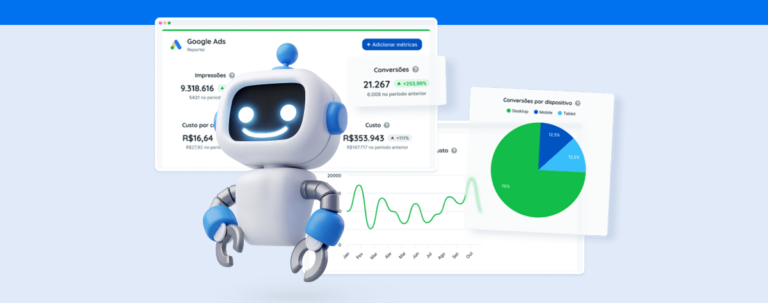Learn what Return on Investment truly entails and how this metric holds the key to unraveling the success of your campaigns.
When it comes to digital marketing strategies, the pursuit of Return on Investment (ROI) takes center stage.
This pivotal metric holds the key to validating the efficacy of your campaigns and unveiling the profits reaped by your company, illuminating the path to achieving even more positive outcomes.
In the realm of paid media, where swift returns on investments are paramount, the significance of this data surges within your reports and analyses. In this comprehensive article, we unravel the essence of ROI, guiding you through calculating it for your traffic campaigns and offering invaluable tips to glean insightful wisdom from this metric. Keep reading!
What ROI is and how to calculate it
ROI, short for (Return on Investment) is critical data that holds the power to assess the profitability of any investment or project, be it within or outside the realms of digital marketing.
Beyond specific actions, such as paid media, ROI extends its reach to broader scenarios, offering insights into a company’s overall performance and profitability, encompassing costs, inputs, employee expenses and more.
So, how do we calculate this influential metric? It’s simple! By subtracting the investment cost from the investment gain and dividing that by the same cost value. The result, usually presented as a percentage or decimal value, highlights the true essence of ROI. The formula looks like this:
ROI = (Investment Gain – Investment Cost) / Investment Cost
For instance, if an investment of $10,000 yields a return of $12,000, the calculation stands as follows:
ROI = (12,000 – 10,000) / 10,000 = 0.2 or 20%
This signifies a remarkable 20% ROI, signaling a successful return on the initial investment.
When it comes to ROI, we recognize its pivotal role in evaluating the efficiency and viability of an investment. A higher ROI signifies greater profitability, while lower or negative values raise the alarm, prompting companies to seek alternative routes to bolster sales and foster prosperity.
ROI x ROAS
In a nutshell, ROAS hones in on a specific aspect – measuring the return on investment in advertising and marketing campaigns, with an exclusive focus on the financial outcomes derived from sales generated through ads.
Calculating ROAS is a breeze; it simply involves dividing the revenue generated by the campaign by the amount spent on advertising. A simple yet powerful formula:
ROAS = Revenue Generated by the Campaign / Amount Spent on Advertising
For example, suppose a company invested $5,000 in an advertising campaign and reaped $25,000 in sales from the same campaign. In that case, the ROAS calculation is:
ROAS = 25,000 / 5,000 = 5
This means that for every $1 invested, the company garnered $5 in revenue, rendering the campaign highly profitable for the business.
However, it is crucial to remember that ROAS does not encompass other costs associated with the campaign, such as ad production or expenses for marketing agencies or traffic managers. It solely considers the advertising expenditure and the resulting revenue generated by the campaign.
In contrast, ROI is a comprehensive metric evaluating the return on investment, accounting for all associated expenses, and transcending the amounts disbursed to paid media channels. It finds application in projects, marketing campaigns, or asset acquisitions.
Thus, it is paramount to consider ROAS and ROI together in order to gain a comprehensive and granular perspective on your digital advertising investments.
How ROI helps you analyze your paid traffic campaigns
When it comes to paid traffic campaigns, ROI emerges is a paramount metric, rendering invaluable insights across various facets of your analysis. Let’s explore some of its primary roles:
- – Profitability Assessment: ROI delves deep into the financial returns achieved in relation to the investments made keeping you up to par on which campaigns generate a positive return, while pinpointing those that may yield losses, shaping the trajectory of your strategy.
- – Performance Comparison: facilitates informed decisions regarding resource allocation and optimization of your advertising budget. By comparing the performance of diverse campaigns, you pave the way for strategic advancements.
- – Identifying Areas for Improvement: From fine-tuning audience targeting to optimizing creative elements or refining landing pages, the focus shifts to what truly propels your strategy forward.
- – Setting Goals and Monitoring Progress: You can keep a vigilant eye on progress towards your objectives ensuring that efforts are meticulously attuned to your overall business goals.
In essence, ROI serves as the bedrock for scrutinizing paid traffic campaigns, so you can gauge profitability, find out what actions to improve, and bolster advertising investments. That way, you’ll make astute decisions to amplify your online presence.
How to improve the ROI of paid media campaigns
To reach paid campaign success and amplify your ROI, consider adopting these tried-and-true practices:
- 1. Continuously monitoring clear and measurable goals will help you chart your course and evaluate financial outcomes achieved to gauge the success of your campaigns.
- 2. Study and segment your target audience. Delve deep into audience demographics, interests, and behaviors to curate a refined targeting strategy. Ensuring your ads reach the right eye heightens conversion probabilities and helps you avoid wasting resources.
- 3. Embrace multi-channel testing across channels like Google Ads, Facebook Ads, LinkedIn Ads and others to uncover what resonates best with your business.
- 4. Choose insightful metrics that capture the essence of your paid media campaigns. For optimal efficiency, employ a report automation tool like Reportei to help you optimize time and aid in astute decision-making.
- 5. For campaigns on search engines like Google Ads, optimizing keywords is paramount to success.
- 6. Gauge the efficacy of various ad elements through A/B testing. Investigate headlines, images, calls to action, and more to find top-performing variations and adjust your strategies accordingly.
- 7. Track value through the customer lifecycle. Fostering customer loyalty and retention encourages repeat purchases, elevating the average value per customer and resulting in ROI growth over time.
Remember, the journey to elevating your paid media campaign ROI is an ongoing process. Monitor, assess, and adapt your strategies in response to results, persistently striving for financial growth.
Did you like reading about the ROI of paid traffic campaigns and the insights you can extract from them?





